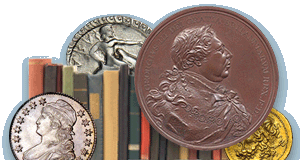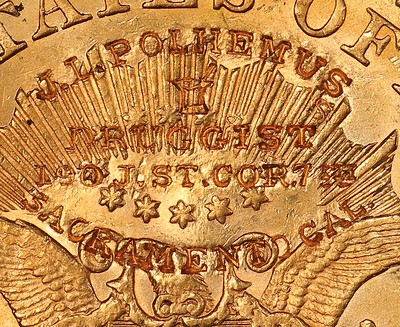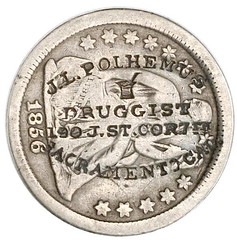
PREV ARTICLE
NEXT ARTICLE
FULL ISSUE
PREV FULL ISSUE
TREASURE TALK WITH BOB EVANS, EPISODE 7.2In January, our good friend Bob Evans began publishing a series of blog articles on the Finest Known website detailing his experience as co-discoverer and curator of the treasures recovered from the wreck of the S.S. Central America. Subject of the book "Ship of Gold", many exhibits, countless interviews and articles, books and auction catalogs feature the legendary haul of gold coins, bars, nuggets, gold dust and more from the 1857 shipwreck. Here's another excerpt - see the complete article online. -Editor The sheer numismatic variety that passed through my hands as I sat at that table was a constant challenge. Many pieces were encrusted, and the details could not be discerned through the mineral matrix enclosing them. That data would remain blank on the inventory spreadsheet until finally resolved during curating in the lab in 2018. I wore exam gloves, and everything was wet. Some things smelled very bad, particularly the items that emerged from the safe, a deep-sea, enclosed, refrigerated swamp that sat on the seabed in a state of anaerobic fermentation for 157 years. A small sign, "Smell the History!" was posted on the door to the Coin Room. It is hard for some to imagine that treasure recovery is sometimes a "Dirty Job." But as we endured the odor, wonderful coins appeared before me, raw and rusty, but also fresh and glistening, and not seen for 157 years! There were three coins found in the sediment collected during Dive 57, two seawater-effected silver coins and this little wonder. As it sat on the exam table I saw the counterstamp first. By now this was a familiar stamp to me, although it always delights me. It's one of the more spectacular counterstamps in existence, in my opinion and I'm sure that of many others. Some merchants in the 19th century used to advertise by stamping their names or the names of their businesses on circulating coins. In this case the merchant, a druggist, wanted you to know much more, and the result was a stamp that is wonderful and popular among collectors of counterstamps. Such stamps are found most commonly on silver and base-metal coins, but on the SSCA we found them on gold. I had seen this stamp before on double eagles, well-centered over the sunburst and ring of stars on the reverse (tails) side. Mr. Polhemus wanted possessors of these coins to know not only who he was, but where he was and what he did. He commissioned a logotype stamp (a single punch, instead of separate words or letters) with the full information: "J. L. POLHEMUS / DRUGGIST / 190 J. ST. COR. 7th / SACRAMENTO CAL." It's almost like you could mail these coins back to him! Adding to the charm is a miniscule mortar and pestle, just below his name. Here is the coin after curating, with the reverse surface free of rust and minerals. According to Winter (2006, Gold Coins of the New Orleans Mint, 1839 – 1909, 2nd Edition,) in the modern numismatic market, the 1854 is one of the more readily available New Orleans quarter eagles, particularly in the lower grades. But think of the route these atoms of gold took. Following the discovery of gold in 1848, all the United States Mints began to receive large deposits of California gold, the main Mint in Philadelphia, as well as the Branch Mints in Dahlonega (GA), Charlotte, and New Orleans. This kept the Appalachian branches in business following the exodus of many local gold miners to the more lucrative hills and streams of the Sierra Nevada. At New Orleans, California gold become most of their supply, with a small amount coming from foreign exchange, as it had since the establishment of the New Orleans Mint in 1839. But California was their principal source at this time. In fact, during the initial surge of the Gold Rush from 1849 through 1852, almost all the gold coined at the New Orleans Branch Mint came from California deposits. So it is probable that most or all of the gold that ended up in the alloy of this quarter eagle made in New Orleans came from California. From there, the gold made it back to California, to J Street in Sacramento. We see that in the druggist's counterstamp. Then it circulated until finding its way headed back to the east on the S.S. Central America. Then it sank, and sat at the bottom of the Atlantic for 157 years until found and rescued.
To read the complete article, see:
For the complete series, see:
To read the earlier E-Sylum article, see:
Wayne Homren, Editor The Numismatic Bibliomania Society is a non-profit organization promoting numismatic literature. See our web site at coinbooks.org. To submit items for publication in The E-Sylum, write to the Editor at this address: whomren@gmail.com To subscribe go to: Subscribe All Rights Reserved. NBS Home Page Contact the NBS webmaster 
|







